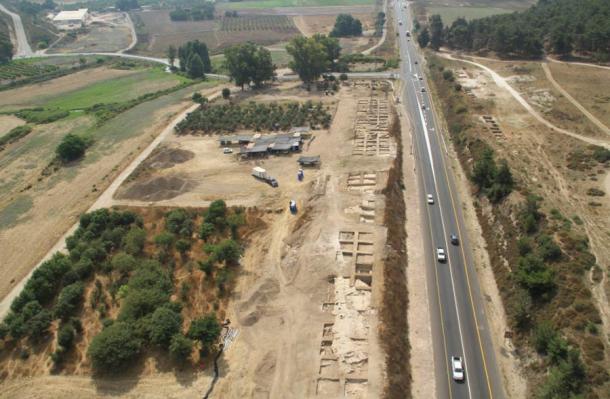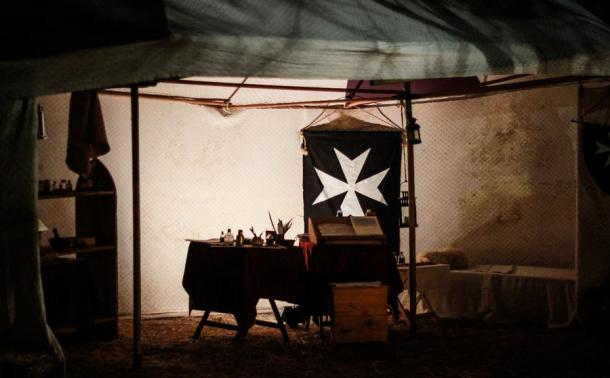A highways expansion project in the Tzipori Springs area in Galilee in Israel has uncovered fascinating evidence of a 12th-century Crusader battle camp. Exploratory excavations undertaken by a team of archaeologists before road widening work on the highway linking Nazareth to the Mediterranean Sea has found the campsite.
Nimrod Getzov and Ianir Milevski of the Israel Antiquities Authority (IAA) conducted the excavation with assistance from Rafael Lewis , an archaeologist at the University of Haifa. They have published their findings in the book Settlement and Crusade in the Thirteenth Centur y. The archaeologists used a technique known as ‘artifact distribution analysis’. “We started by reconstructing the landscape as it approximately looked like at the time; we considered where the artifacts were found; and compared what we learned to historical records, ” Dr Lewis told the Jerusalem Post .

Aerial view of the excavations at Ein Tzipori during the 2012 season. (photo credit: COURTESY OF ISRAEL ANTIQUITIES AUTHORITY)
The Crusades, the Frankish Kingdom of Jerusalem and the Battle of Hattin
The Crusades, also known as the ‘Holy Wars’ were a series of attacks undertaken by European Christian armies on the Levant region between the 11th and 13th centuries. They were intended to wrest possession of the ‘Holy Land’ from the Ayyubid Sultan and to reverse and stem the onward march of Muslim expansion in the Middle East. Between 1099 and 1187, the Crusades placed Jerusalem under Frankish Christian rule until the Battle of Hattin spelt a decisive defeat for the Christian forces at the hands of the Muslim armies under Sultan Saladin.
While there is lot of evidence in the form of written records and chronicles as well as in the form of castles and fortifications to document the European Christian presence in the Levant, so far, no evidence had been found of actual battlefields and encampments. However, “The area along Route 79 was known as the site of the Frankish encampment ahead of the battle of Hattin in 1187, as well as for other encampments by both the Crusaders and the Muslims during a period of 125 years,” Dr Lewis told the Jerusalem Post . According to written records of- the time, the Christian army was stationed in the Tzipori Springs area for around two months ahead of the crucial battle.

The discovery of the Tzipori Springs campsite is the first evidence of a Crusader encampment. Source: DMAH / Adobe Stock
The Crusader Encampment at Tzipori Springs
The archaeologists unearthed hundreds of metal artifacts ranging from coins, needles and arrowheads to horse-grooming equipment and equipage such as bridles, harness fittings, a currycomb, horseshoes, and horseshoe nails, both sophisticated ones made in Europe and simpler ones of local origin, indicating at least a temporary settlement. Dr Lewis is reported by Mail Online to have said, “It was a very exceptional opportunity to study a medieval encampment and to understand their material culture and archaeology.”
“I see an interesting pattern similar to that in contemporary army camps. The men are awaiting the fight and are meanwhile bored, fearful and troublesome. In short, it is a dangerous situation and the last thing their commanders want them to do is have the leisure to think. And at Tzipori, a major activity seems to have been replacing broken horseshoe nails, which went beyond make-work for its own sake.”
Interestingly, more high-class artifacts including the European-origin horseshoe nails were found closer to the water. This, the archaeologists concluded, indicated that persons of higher socio-economic status were encamped next to the spring. “Changing those nails probably represented the main activity in the camp,” Lewis is quoted to have said by the Smithsonian Magazine . “Nobody wanted to find himself in the battle on a horse with a broken shoe.”

Archaeologists found several Crusader arrowheads at the site. Photo credit: Clara Amit / Israel Antiquities Authority
The team also discovered a large quantity of ‘aristocratic artifacts’—gilded buckles and hairpins, manufactured in the European style and probably used by knights and other elite members of the Crusader armies. Although all of the troops at the time fought loosely under the Frankish king, they did not serve in a centralized army. Disparate groups of knights came together for battle, each with its own camp and each under its own commander.
However, surprisingly, artifacts indicating other activities which must have formed part of everyday life at the camps have not been found. This includes cooking vessels. This probably meant that such equipment was packed up and moved back to the castles and permanent settlements once camp broke up.
The archaeologists hope to find evidence of similar sites used by Crusader armies across the region soon. According to them, this will add tremendously to our understanding of that eventful period in the history of the Middle East.
Top image: A crusader at his campsite Source: dieterjaeschkephotos / Adobe Stock
By Sahir Pandey
Related posts:
Views: 0
 RSS Feed
RSS Feed

















 October 24th, 2021
October 24th, 2021  Awake Goy
Awake Goy 




 Posted in
Posted in  Tags:
Tags: 
















